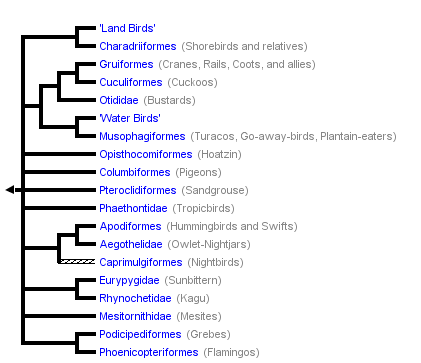




Domain: Eukarya
Kingdom: Animalia
Phylum: Chordata
Class:
AvesOrder:
Phoenicopteriformes*Family:
PhoenicopteridaeGenus:
PhoenicopterusSpecies:
Phoenicopterus ruberSubspecies:
Phoenicopterus ruber ruber
The Caribbean Flamingo is classified into the Domain Eukarya because it contains cells with membrane bound organelles. These cells are eukaryotic, hence the name Eukarya. It is also in the kingdom Animalia because it is a heterotrophic organism, so it relies on another source to obtain its nutrients. Chordata was assigned as its phylum because the flamingo had a notochord early on in its development. Along with a dorsal hollow nerve cord, pharyngeal slits, and a post anal tail. The flamingo is classified into the class Aves because it is a bird, which means that it is a warm blooded egg laying vertebrate that has feathers, wings modified for flight, and an active metabolism. The order is Phoenicopteriformes because many people feel that flamingos belong in their own group, even though this is still being debated.. All flamingos belong to the family Phoenicopteridae, except they all don't have the same genus name. Only two out of the five species of flamingo are given the genus Phoenicopterus, and this is because the flamingos in this group all have yellow eyes and a shallow keeled bill with lamellae on the inside. Phoenicopterus ruber is the scientific name for the Greater Flamingo which is further divided into two subspecies. The subspecies name for the Caribbean (American) Flamingo is Phoenicopterus ruber ruber and the subspecies name of the Greater Flamingo is then Phoenicopterus ruber roseus.
Genus: Phoenicopterus
![]()
![]() P. chilensis
P. ruber
P. chilensis
P. ruber
Chilean Flamingo
Greater Flamingo

P. ruber ruber
Caribbean Flamingo P. ruber roseus
As you can see the Greater Flamingo (P. ruber roseus) is slightly larger than the Caribbean Flamingo and is pale with deep pink wings. The Greater Flamingo also lives in different parts of the world. See Geography to learn more about where the Caribbean Flamingo lives.

Five Different Species of Flamingos!
![]()
![]()
![]()
![]()


![]()
